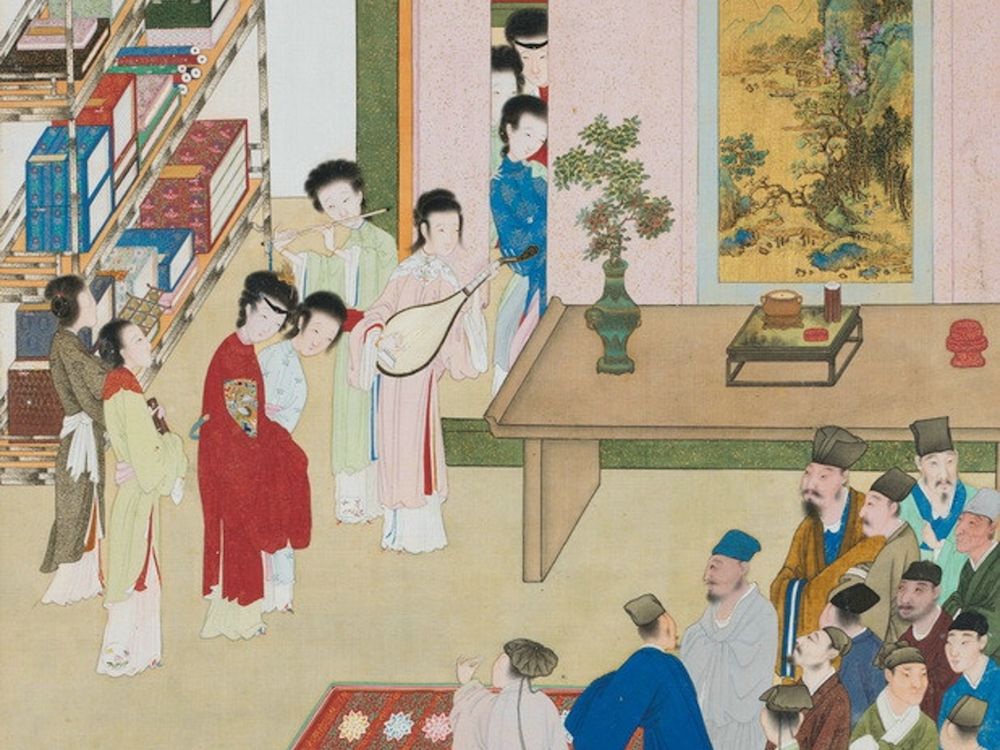Alanna Reeves, a visual artist and writer from Washington, D.C., is an emerging voice in contemporary American art. When Reeves and I went to school together growing up, everyone wanted to model their handwriting after hers. But it was in art class with the printmaker Percy B. Martin that it became clear she was much more than her fastidious script, that she was the real deal. Five years after receiving her B.F.A. in illustration and art history from the Rhode Island School of Design, Reeves has indeed made her mark. Last week, she partook in a virtual conversation hosted by Strathmore, offering an overview of her recent work and the theory behind it. The first piece discussed, Límon, was perhaps the most striking: a black-and-white photograph of her paternal grandfather overlaid with yellow embroidery floss in a design inspired by cross-stitch patterns. In much of her work, Reeves reexamines her girlhood pastimes, such as cross-stitch and paper dolls—activities with sets of prescribed patterns and rules. One audience member observed that the stitching looked almost like a chain-link fence, barring uninhibited access to the subject yet inviting the viewer to peer through nonetheless. Reeves agreed, noting that she purposefully left his eyes untouched. Only the corner and lid of one eye are embroidered, delicately stitched in a freehand that deviates from the otherwise geometric pattern. Now Reeves has been doing more printmaking, which, to me, recalls the early influence of Martin. The pandemic has not stopped her momentum, and she will be exhibiting work with D.C. Arts Center in the fall and Strathmore in January. In the meantime, you can keep up with her work on Instagram. —Elinor Hitt
In Italian, arcipelago is a near-cognate to the English archipelago, missing only the h: a letter of exhalation, ventilation. The latter word provides the title for one of the only book-length surveys of Antonella Anedda’s work to be published in English, translated from the Italian by Jamie McKendrick. Ventilated these poems are: whether it is the “stones, / refueling themselves with wind at every stop,” a “breeze seeping from the heart of the rocks,” or the “air between the orange trees the living gently displace,” the landscape is alive with respiration, while the human figures fail to catch their breath, such as “the drunkard who yesterday on the windy dock / was rocking and singing with his mouth shut.” Anedda’s ancestral Sardinia is the grand subject of her work, featuring prominently in a beautiful cluster of poems named after Maddalena Island. In one of these, the speaker pauses to “blow on the Bocche,” another fixture of Italian geography with a near-silent h, a mountain range in Northern Italy whose name literally translates to “mouths”—the poet, poem, and physical world breathing out as one. —Lauren Kane
Jackie Kay is Scotland’s Makar—our national poet—and The Adoption Papers (1991) is her first collection. Kay, who is of Scottish and Nigerian descent, was brought up by white parents in Glasgow, and the adoption referenced in the title is her own. For the first half of the book, three voices are given three different typefaces: Palatino, Gill, and Bodoni. These represent the three women of the adoption triangle: Kay, her adoptive mother, and her birth mother. At first, one might find oneself looking back at the typeface key, making sure of the voice, but as the poems progress, the familiar thoughts, worries, and cadences of each voice are sufficient context to abandon this stop and check. One sees emerging those themes that will reappear in Kay’s later works: belonging, identity, race, and, of course, love. As Ali Smith once noted, Kay writes from “a literary tradition of shapeshift itself, one that finds voice in unauthorised, unexpected forms and places; one often concerned with the search for a communal form.” And it is this search for communal form, I think, that drives the second, less autobiographical part of the collection, “Severe Gale 8.” In Scotland, at the time of Kay’s writing, nothing felt more communal than opposition to the Tories. “There was no bread,” she writes of eighties Britain, when the bankers “sang their tune at the Stock Exchange.” “There was no bread,” when Thatcher’s “Poll Tax / arrived that winter of the second hurricane.” “There was no bread,” in the decade “when every cardboard city / was so jam-packed that strangers / recognized each other’s smells.” Things are arguably no easier now. The difference today, of course, is that the Scottish Government, established in 1999, is able to position itself between the misdeeds of Westminster and the Scottish electorate. This accounts, perhaps, for the groundswell of support for that other search for a communal form: Scottish independence. —Robin Jones
For more than a decade, the Maryland-based duo Wye Oak has been my favorite working noninstrumental music ensemble. Songwriter Jenn Wasner has a voice that approaches Joni Mitchell–like power and pettiness, and certainly looks back toward Joni for how to create melodies and lyrics that have story and drama coded in them. And Andy Stack, the producer and drummer-keyboardist (onstage, he plays both at the same time in a totally ungimmicky way, purely for efficiency), is a sort of invisible wizard. Wasner’s new digital-only solo EP under her Flock of Dimes moniker, Like So Much Desire, shows her to be no less formidable an artist without Stack’s presence. The songs are more piano- or keyboard-centric, without all of Wye Oak’s marvelous genre slaloming, and make for simply beautiful, often breathtakingly so, music to listen to when alone—and who isn’t alone these days? This duo is having a busy month despite lockdown, as today marks the release of Wye Oak’s new five-song EP, No Horizon, a set of indie rock tunes layered atop a bed of choral singing by the Brooklyn Youth Chorus. It’s just magisterial music, transcendent, huge music, yet also sad, intimate, probing. How wonderful it is to hear these artists at the peak of their powers, now a long-lived band but more ambitious than ever. I can’t wait for what’s next. —Craig Morgan Teicher
Four months ago, when I was young, I became obsessed with a relationship map of a group of polyamorous, pansexual, occasionally incestuous (but I prefer not to dwell on that) penguins. They paired and parted, frolicked and feuded; woven among them were the aquarium staff, the penguin handlers, some of whom were bound to the penguins only by being despised by the penguins. I was longing for tumult and—oh God—scandal. In essence, I had been starved for gossip since lockdown. But no matter how charming, the love lives of penguins were no substitute for the mess of human intrigue. So I started The Plum in the Golden Vase, rendered in an extraordinary, erudite, and exhaustive translation by David Tod Roy that spreads over five thick volumes and more than three thousand five hundred pages. Signed off by the “Scoffing Scholar of Lan-ling,” apocryphally this sixteenth-century masterpiece was written for the only reason novels should ever be written: revenge. The myth holds that Wang Shizhen wrote a page-turner and then made a toxic ink, or sprinkled a lethal powder on the corner of every page, waging his nemesis would tear through it, licking his fingertips to turn the pages. The Plum in the Golden Vase is the most delicious poison. The Chinese title, Jin Ping Mei, gives some clue to the layers with which the book was written: it is at once a lovely image of plums in golden vases, a combination of characters from the names of three central women in the novel, and a dirty joke. The book itself was a scandal—dismissed as pornographic and evil, frequently censored and banned, even as it was loved, studied, and imitated. The frank sexuality is part of the novel’s uncommon attention to how people live with one another and how gender, power, and desire shape character. Both wayward and impossibly intricate, it centers on the merchant Hsi-men Ch’ing and his many wives, concubines, children, and servants (Roy uses Wade-Giles romanization rather than pinyin, a choice that contributes to the book’s length). There is scandal by the dozen, and quite possibly everything else, from feasts and faux pas to drinking games, pranks, aphrodisiac overdoses, mean monks, murders, and lengthy arguments about the use of laundry bats. The novel is endlessly allusive, slipping into or parodying classical verse, and Roy catalogues it all in absurdly comprehensive footnotes. His translation also has a playfulness and energy; the insults can be so gloriously zany you pray for an occasion to deploy them (“You crazy chunk of knife-bait!”). The Plum in the Golden Vase has such vitality, such depth of characterization, that it makes life seem drab. It possesses a detail and complexity that seem to halt time. All right, I admit I haven’t finished it yet. But my time at The Paris Review is up. Besides, this is a book to read for the rest of your life. —Chris Littlewood
from The Paris Review https://ift.tt/39MyRKE



Comments
Post a Comment